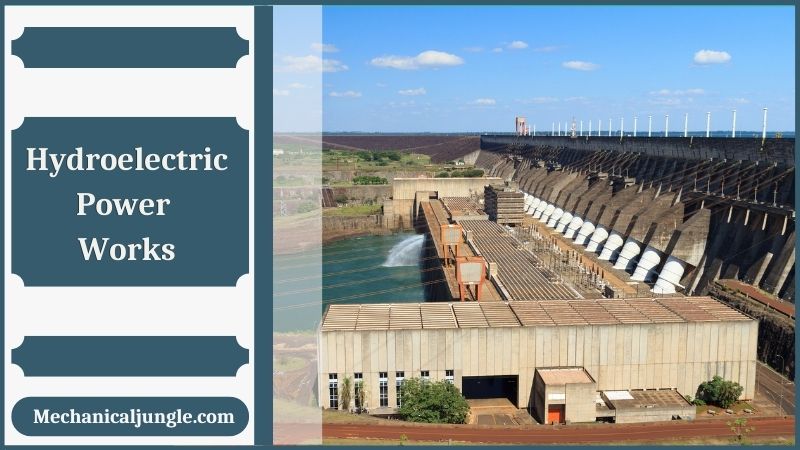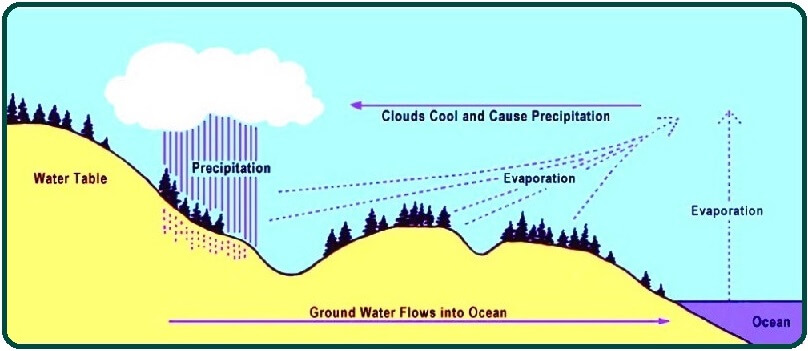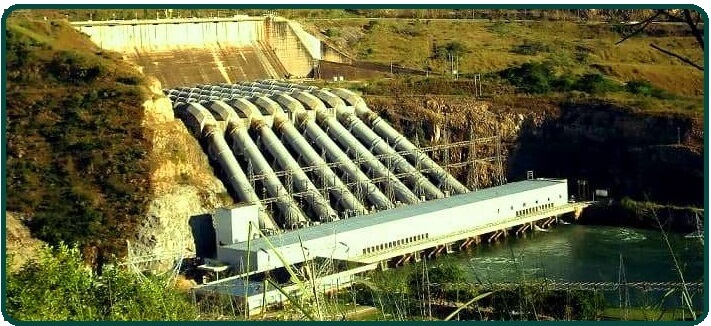
How Hydroelectric Power Works

Hydroelectric power comes from waters at work, water in motion. This can be viewed as solar energy, as the Sun powers the hydrological cycle that gives Earth its water. In the hydrological cycle, atmospheric water reaches the Earth’s surface in the form of rain.
Some of these waters evaporate, but much of it either percolates into the soil or becomes surface runoff. Water from rain & melting snow eventually reaches ponds, lakes, reservoirs, or oceans where evaporation is taking place continuously.
Moisture seeping into the soil can become groundwater (subsurface water), some of which also enters water bodies through springs or underground streams. During dry periods groundwater can move upward through the soil and return to the atmosphere by evaporation.
Water vapor evaporates into the atmosphere, then circulates, condenses into clouds, and some return to Earth as precipitation. Thus, the water cycle is complete. Nature ensures that waters are a renewable resource.
Advantages of Hydroelectric Power:

Hydropower has many advantages and can be considered a promising technology in the transition process from fossil to renewable energy. Let’s take a looks at the benefits of harnessing the incredible power of running water.
#1. Renewable and Sustainable
Hydroelectricity uses the energies of running water to generate electricity without reducing its volume. It will still be a sustainable powers source if infrastructures surrounding such power are sophisticated enough to meet challenges related to global warming.
#2. Green and Clean Energy Sources
The energy produced by hydroelectric does not create any toxics or greenhouse gases polluting the environment.
Hydroelectric plants emit fewer greenhouse gases than fossil-based power sources, which helps mitigate climate change, acid rain, and haze. Hydroelectric powers also improve the air quality we breathe because they do not emit air pollutants.
#3. Fundamental Vehicles for Sustainable Development
Hydroelectric enterprises that develop and operate in an economically viable, environmentally sensible, and socially responsible manner represent the best concept of sustainable development. It supplies highway construction, attracts various industries, and promotes commerce as a whole.
#4. Domestic Power Source
Unlike electricity generation with fossil fuels, the production of hydropower does not require mining or shipping the fuel over very long distances. There is no mining involved in hydropower generation, and the water will be converted into energy where the power plant is installed.
#5. Promotes Guaranteed Energy and Price Sustainability
Despite the expensive upfront construction cost, hydroelectricity is a cost-competitive source of energy. River water is a domestic resource that, unlike fuel or natural gas, is not subject to market fluctuations.
In addition, it is the only major renewable source of electricity, and its cost-benefit ratio, efficiency, flexibility, and reliability help optimize the use of thermal power plants.
#6. Creates Jobs
Especially in areas where there is a high level of unemployment, the construction of hydroelectric plants can be an opportunity to create jobs and improve the overall living conditions of the local populations.
As a result, the average incomes of the local population increase, which in turn increases the level of consumption and tax revenue.
#7. Contribute to the Development of Remotes Communities
Hydroelectric power plants supply electricity to remote communities, attracting the construction of highways, industry, & commerce.
All these activities serve to uplift the economies of these remote areas, increase access to education & healthcare, and enhance the overall quality of life of the residents.
#8. Recreational opportunities
The lake formed behind the dam can be used for recreational opportunities, offering activities such as fishing, boating, and swimming. The water of the lake can also be used for irrigation. Apart from this, big dams have become the center of tourist attractions. It can boost the nearby cities economically.
Disadvantages of Hydroelectric Power:

The flip side of all these advantages of hydroelectric energy is the disadvantages of hydroelectric energy. However, this is not true, and hydroelectric power has a negative impact on the environment and local ecology. Here are some of the main disadvantages of hydroelectric power.
#1. Environmental Impact
Interruptions in natural water flow can have huge impacts on the environment and river ecosystem. Hydropower facilities can affect land use in the dam area, river valley forests, marshlands, and grasslands.
Reservoirs can cover people’s homes, important natural areas, agricultural land, and archaeological sites.
Areas that were previously covered by water may dry up, and those that have dried up may be covered by water. In turn, these changes in natural living conditions can confuse many animal and plant species, leading to a reduction in those species and imbalances in local ecosystems.
#2. High Construction Cost
Hydroelectric power plants & dams can be incredibly expensive to build. In addition, projects take a longer time to complete, and recovery of the money spent on construction would also require long hours.
For example, compared to the falling prices of solar installations, hydropower is a more challenging renewable project to finance.
#3. Limited Reservoir
Although water is a limitless resource, the conditions required to build a dam are limited. The efficient production of hydroelectricity requires large rivers or streams to provide enough water.
With the right amount of water and fairly close to existing power lines, it is challenging to find a suitable location that has a year-round water supply.
#4. Drought Potential
When weighing the advantages & disadvantages of hydroelectric energy, it is essential to consider the fact that water can & does go through cycles of abundance & drought. One of the main disadvantages of setting up hydroelectric power plants is the occurrence of local droughts.
#5. Border Conflicts
Rivers often represent the borders between the two countries. When it comes to making decisions regarding the construction of hydroelectric plants, both countries have to agree that the construction is in line with the goals of both countries.
If one country wants to build a hydroelectric power plant and another country does not, there can be serious conflicts between those countries which may even result in wars in the worst case.
#6. Relocation Due to Risk of Floods
Local populations living downstream may be vulnerable to flooding due to potentially strong water currents flowing from dams. As a result, peoples have to relocate to the dam construction facilities needed to generate hydroelectricity.
The World Dam Commission estimated in 2000 that dams physically displaced 40–80 million people worldwide.
#7. Degradation of Water Quality
The final disadvantage of hydroelectric power on our list is water quality. When dams are built, they limit the flow of water, which affects the oxygen level in the water.
Low oxygen levels behind the dam can also reduce oxygen levels downstream. When there are not as many oxygens in the waters, it is more difficult for some species of fish to survive, which affects the habitat of the river.
Frequently asked questions (FAQs) that could complement your article on hydroelectric power:
What is hydroelectric power?
Hydroelectric power refers to electricity generated by harnessing the energy of flowing water, typically through the use of dams and turbines.
How does hydroelectric power work?
Hydroelectric plants use the kinetic energy of moving water to spin turbines, which in turn generate electricity through a generator.
What are the advantages of hydroelectric power?
Hydroelectric power is renewable, produces clean energy, contributes to sustainable development, provides domestic energy security, creates jobs, and supports local economies.
What are the environmental impacts of hydroelectric power?
Hydroelectric projects can disrupt ecosystems, affect river flows, alter habitats, and impact biodiversity. They may also lead to downstream water quality issues.
How expensive is it to build a hydroelectric power plant?
Building hydroelectric dams and power plants can be costly and time-consuming, requiring significant upfront investment and long-term planning.
Can hydroelectric power contribute to climate change mitigation?
Yes, hydroelectricity produces fewer greenhouse gases compared to fossil fuel-based energy sources, making it an important component of renewable energy strategies.
What are the social impacts of hydroelectric projects?
Hydroelectric projects can lead to displacement of communities, changes in local livelihoods, and social conflicts over water rights and land use.
Are there alternatives to large-scale hydroelectric projects?
Yes, smaller-scale hydroelectric systems like micro-hydro and run-of-river projects can minimize environmental and social impacts while still generating renewable energy.
How does hydroelectric power contribute to water management?
Hydroelectric dams can provide flood control, regulate water flow for irrigation and municipal use, and create reservoirs for recreational activities.
What is the future outlook for hydroelectric power?
The future of hydroelectricity includes advancements in technology to improve efficiency and mitigate environmental impacts, alongside increased integration with other renewable energy sources.

